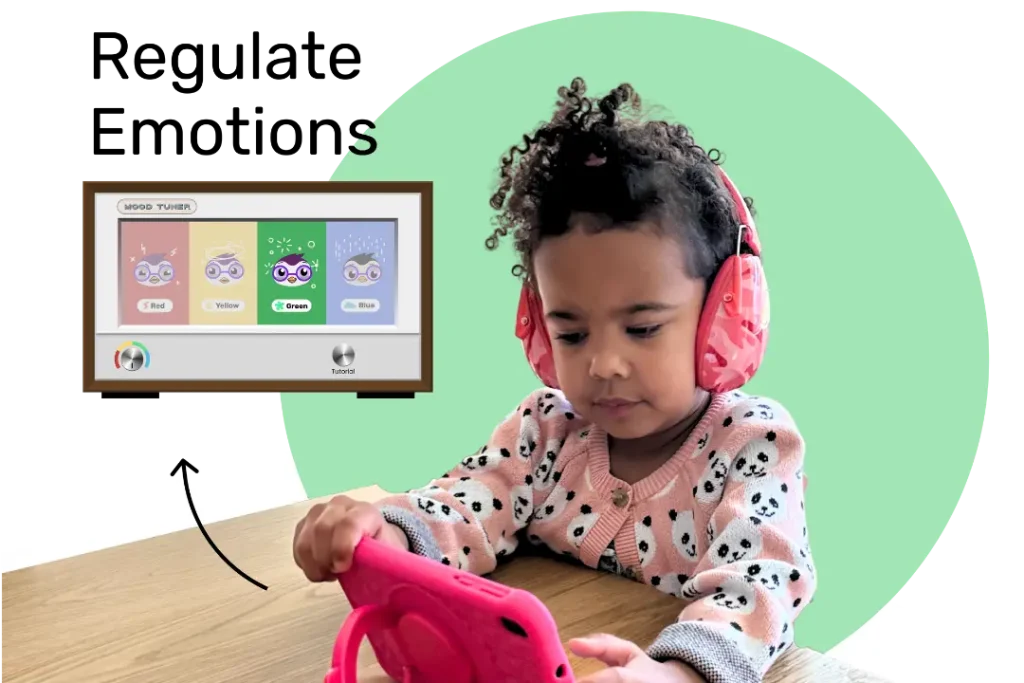My best friend is a single mom to an autistic little boy, and I love to witness their special bond. Kids always feel a wide range of emotions. Still, neurodivergent kids might see this emotional world through a slightly different lens. Teaching children about feelings can help them develop empathy, communication, and understanding of their emotions. Here’s why teaching our kids about emotions is so important, and several age-appropriate ways you can do it to make a positive difference in your own child’s life.
Table of Contents
Why Teaching About Feelings is Important
Kids feel all sorts of things – from the bubbling excitement of a birthday party to the frustration of a broken toy. Teaching about feelings is important because solid emotional skills empower kids to:
- Build empathy and connect with others: Kids who can understand their own emotions are usually better at understanding the emotions of others, leading to better relationships with their friends and peers.
- Manage their emotions: When kids understand their feelings, they can better handle them healthily. Openly talking about emotions is the first step to helping our kids feel less afraid, confused, or overwhelmed.
- Communicate and assert their needs: If kids don’t have the words to explain their feelings, they might misbehave or shut down. We can help by giving kids the vocabulary to say things like, “I feel mad because…” or “I’m too frustrated to work on this now.”
How to Teach Kids about Feelings
Now, let’s explore ways to build emotional intelligence in children of all ages.
Model
Kids learn greatly by watching us and how we act in different situations. Here’s how your behavior can model healthy coping skills and emotional expression:
- Express your own emotions. It’s okay for kids to see you feel emotions – happy, sad, frustrated, everything in between! They’re learning from you every day.
- Label your emotions out loud. While you’re expressing yourself, label those emotions, “I’m feeling a little grumpy because I’m tired” or “This traffic makes me feel frustrated.” It helps kids connect a name to the feeling.
- Talk through challenging emotions. When you’re struggling with something, use those moments to explain how you’re feeling and how you’ll cope, “I’m feeling overwhelmed today, so I’m going to take a little break.”
Goally | The Safest Tablet for Kids

Use Words
- Name their feelings out loud. Helping kids identify their feelings is the first step in empowering them to manage them. You can say, “Your face is all scrunched up; does it feel like you might be angry?” or, “I noticed you’re hitting your sister; I wonder if you’re feeling frustrated?”
- Build a feeling vocabulary. Kids need various words to describe their emotions beyond “happy” and “sad.” A feelings chart with pictures and words can be a beneficial visual tool!
Use Activities
Get creative and find age-appropriate ways to bring emotions into your day!
- Books and stories. Reading books or telling stories about characters and their different emotions will help your kids identify feelings in themselves and their friends.
- Songs. There are so many fun songs about emotions – a quick search on YouTube will reveal many excellent options. My best friend’s son loves upbeat songs about feelings, which really calm him down when upset.
- Games. Games like charades are a fun way to practice acting out different emotions. You can also create a feelings scavenger hunt, asking kids to find objects that represent different feelings.
- Play. When playing pretend, try weaving in scenarios that involve different emotions. You could be a shopkeeper while your child is a customer who feels frustrated about a broken toy. This play will help your child identify and act out their feelings.

Read more: Printable Feelings Chart for Kids
Teach Them to Notice
Teaching children to notice how their body feels when experiencing different emotions plays a crucial role in managing intense feelings.
- Notice physical sensations. Ask your kids to notice what happens in their bodies when they feel different emotions. For instance, their heart might beat faster when angry, or their stomach might feel tight when worried. Noticing these changes can help kids recognize the early signs of intense emotion and take steps to calm their bodies and minds, such as deep breathing or movement.
Teach Different Emotions
- Start with the basics. Focus on the most common emotions: happy, sad, angry, scared, and surprised. You can add in more complex emotions as your child gets older or if you notice confusion between different feelings.
- Create a “feelings wheel.” A feelings wheel is a visual with different emotions labeled on it. You can have your child point to the feeling they’re experiencing. It’s a fantastic way to open conversations around emotions.
Teach Emotional Rights
It’s okay for kids to have their feelings! Assure kids that:
- All feelings are okay. Teach kids that all their emotions are valid – even the unpleasant ones. It might help to explain that while feelings are okay, certain behaviors aren’t.
- No feeling lasts forever. When kids are overwhelmed by an immense feeling, reassure them that it will pass.
- They can ask for help. Remind them you’re always there to listen, support, and help them navigate challenging emotions.
Goally | Kid’s Tablet for Building Emotional Regulation Skills
Is your child struggling with understanding and managing their emotions? Goally teaches emotional regulation skills in a fun and interactive way!

The Mood Tuner app encourages kids to look inwards and identify their feelings, helping them understand what’s going on inside. Once they’ve recognized their emotions, they can choose from a variety of exercises designed to help them self-regulate and find their balance.
Teaching our children about emotions isn’t always easy, but it’s a gift that continues to benefit them lifelong. It takes practice and patience, so start where you are. Even small changes and conversations can make a big difference. I promise it will be worth it!
Sources
- The National Child Traumatic Stress Network – This resource includes information on teaching children about feelings, as well as helping kids cope with trauma. https://www.nctsn.org/
- Center on the Social and Emotional Foundations for Early Learning (CSEFEL) – This website provides research-based strategies for teaching social and emotional skills in young children. https://csefel.vanderbilt.edu/
- Understood – An online resource dedicated to helping and supporting parents of children with learning and thinking differences. https://www.understood.org/
FAQ’s About Teaching About Feelings
Why is it important to teach kids about feelings? Teaching kids about feelings helps them build empathy, manage their own emotions, and communicate their needs effectively. How can I teach my child about feelings? Model healthy emotional expression, use words to label feelings, incorporate activities like books and games, and teach kids to notice how feelings feel in their bodies. What are some basic emotions to start with? Start with happiness, sadness, anger, fear, and surprise. What if my child struggles to understand emotions? Use visual aids like a feelings chart, focus on how emotions feel in the body, and be patient – understanding emotions takes time. Are there any resources to help me teach my child about feelings? Yes! Many websites offer resources and activities, such as The National Child Traumatic Stress Network, CSEFEL, and Understood.
Emily is a seasoned blog writer for Goally, leveraging her extensive background in child psychology and special education to provide valuable insights and resources for parents. Her commitment to understanding and addressing the unique needs of these children, combined with her expertise in educational strategies, makes her a credible and empathetic voice for families.





